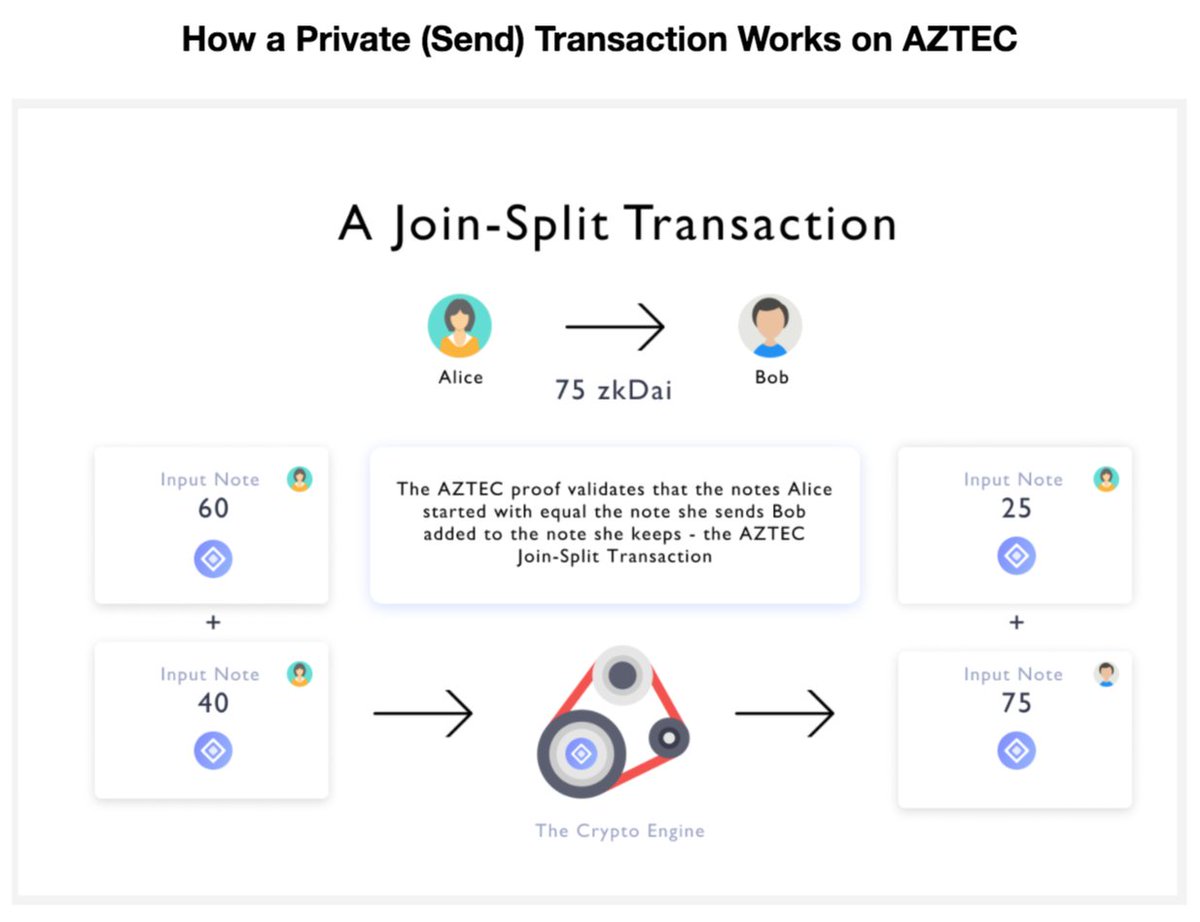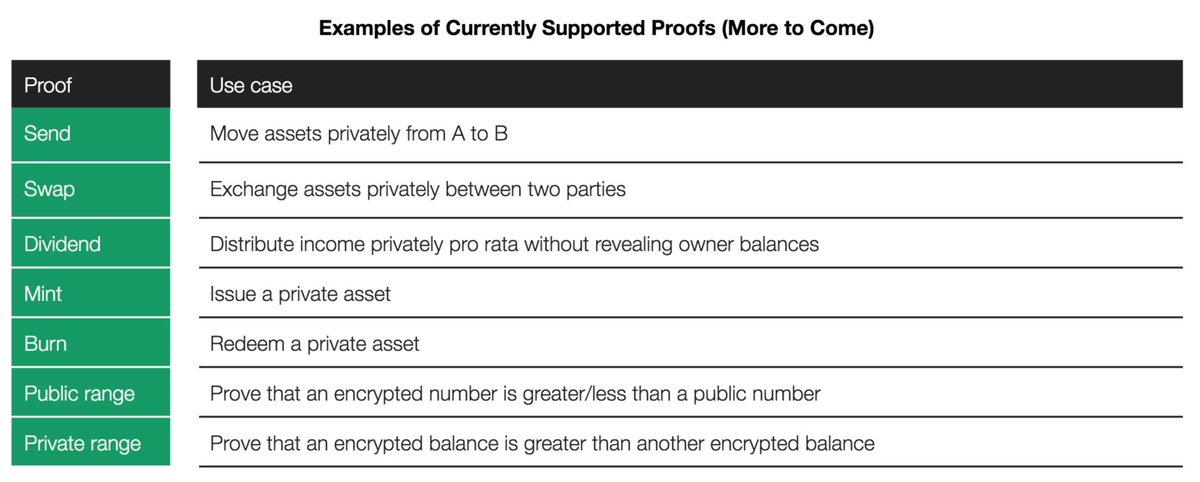1/ ELI5 thread on @aztecprotocol https://abs.twimg.com/emoji/v2/... draggable="false" alt="👇" title="Down pointing backhand index" aria-label="Emoji: Down pointing backhand index">
https://abs.twimg.com/emoji/v2/... draggable="false" alt="👇" title="Down pointing backhand index" aria-label="Emoji: Down pointing backhand index">
AZTEC is a privacy engine for Ethereum.
The team is on a mission to enable data ( https://abs.twimg.com/emoji/v2/... draggable="false" alt="✅" title="White heavy check mark" aria-label="Emoji: White heavy check mark">), user (
https://abs.twimg.com/emoji/v2/... draggable="false" alt="✅" title="White heavy check mark" aria-label="Emoji: White heavy check mark">), user ( https://abs.twimg.com/emoji/v2/... draggable="false" alt="🔜" title="Soon with rightwards arrow above" aria-label="Emoji: Soon with rightwards arrow above">), and code (
https://abs.twimg.com/emoji/v2/... draggable="false" alt="🔜" title="Soon with rightwards arrow above" aria-label="Emoji: Soon with rightwards arrow above">), and code ( https://abs.twimg.com/emoji/v2/... draggable="false" alt="🔜" title="Soon with rightwards arrow above" aria-label="Emoji: Soon with rightwards arrow above">) privacy on public blockchains.
https://abs.twimg.com/emoji/v2/... draggable="false" alt="🔜" title="Soon with rightwards arrow above" aria-label="Emoji: Soon with rightwards arrow above">) privacy on public blockchains.
The protocol is live with private DAI transactions, with more assets (ETH, BTC) launching soon.
AZTEC is a privacy engine for Ethereum.
The team is on a mission to enable data (
The protocol is live with private DAI transactions, with more assets (ETH, BTC) launching soon.
2/ What problem does AZTEC solve?
In CeFi, we’re accustomed to a certain level of transaction privacy.
Transaction privacy is a problem on public and transparent blockchains.
AZTEC enables privacy for on-chain transactions.
In CeFi, we’re accustomed to a certain level of transaction privacy.
Transaction privacy is a problem on public and transparent blockchains.
AZTEC enables privacy for on-chain transactions.
3/ How does it work?
First, some quick terminology: public assets become “notes” in the AZTEC system.
In AZTEC, a note is the “private version” of a public asset: DAI → zkDAI (note).
To understand how notes work, a useful analogy is to think of them as Bitcoin UTXOs.
First, some quick terminology: public assets become “notes” in the AZTEC system.
In AZTEC, a note is the “private version” of a public asset: DAI → zkDAI (note).
To understand how notes work, a useful analogy is to think of them as Bitcoin UTXOs.
4/ Executing a private tx:
1. User creates a zk-proof of the tx notes she wishes to keep private.
2. She sends the proof + tx notes to the AZTEC privacy engine (ACE) for verification of no double-spend.
3. If proof OK → ACE executes the tx as outlined in the proof.
1. User creates a zk-proof of the tx notes she wishes to keep private.
2. She sends the proof + tx notes to the AZTEC privacy engine (ACE) for verification of no double-spend.
3. If proof OK → ACE executes the tx as outlined in the proof.
5/ An example of a private tx:
The privacy engine or ACE executes a transaction only when it can be certain that a transaction’s input notes = output notes.
The privacy engine or ACE executes a transaction only when it can be certain that a transaction’s input notes = output notes.
6/ AZTEC supports many different proofs:
Different proofs, different use cases.
E.g. dividend proofs enable private interest payments by proving that one note (10) represents a set ratio (1/10) of another note (100).
The ratio = the known interest rate (10%).
Different proofs, different use cases.
E.g. dividend proofs enable private interest payments by proving that one note (10) represents a set ratio (1/10) of another note (100).
The ratio = the known interest rate (10%).
7/ Does AZTEC have a native token?
Not yet, but the protocol could launch a governance token where tokenholders have the right to determine which proofs are supported and how much fees are charged for private transactions on the AZTEC protocol.
Not yet, but the protocol could launch a governance token where tokenholders have the right to determine which proofs are supported and how much fees are charged for private transactions on the AZTEC protocol.
8/ In summary:
Through AZTEC, digital assets can finally leverage the security of a public blockchain like Ethereum, without having to compromise on confidentiality -- a necessity for an Internet-based financial system.
Through AZTEC, digital assets can finally leverage the security of a public blockchain like Ethereum, without having to compromise on confidentiality -- a necessity for an Internet-based financial system.
fin/ Shoutout:
This thread was inspired by @jaosef’s presentation on AZTEC held at @defisummit. https://www.youtube.com/watch?v=YyAaZb5ALCM">https://www.youtube.com/watch...
This thread was inspired by @jaosef’s presentation on AZTEC held at @defisummit. https://www.youtube.com/watch?v=YyAaZb5ALCM">https://www.youtube.com/watch...

 Read on Twitter
Read on Twitter AZTEC is a privacy engine for Ethereum. The team is on a mission to enable data (https://abs.twimg.com/emoji/v2/... draggable="false" alt="✅" title="White heavy check mark" aria-label="Emoji: White heavy check mark">), user (https://abs.twimg.com/emoji/v2/... draggable="false" alt="🔜" title="Soon with rightwards arrow above" aria-label="Emoji: Soon with rightwards arrow above">), and code (https://abs.twimg.com/emoji/v2/... draggable="false" alt="🔜" title="Soon with rightwards arrow above" aria-label="Emoji: Soon with rightwards arrow above">) privacy on public blockchains. The protocol is live with private DAI transactions, with more assets (ETH, BTC) launching soon." title="1/ ELI5 thread on @aztecprotocolhttps://abs.twimg.com/emoji/v2/... draggable="false" alt="👇" title="Down pointing backhand index" aria-label="Emoji: Down pointing backhand index">AZTEC is a privacy engine for Ethereum. The team is on a mission to enable data (https://abs.twimg.com/emoji/v2/... draggable="false" alt="✅" title="White heavy check mark" aria-label="Emoji: White heavy check mark">), user (https://abs.twimg.com/emoji/v2/... draggable="false" alt="🔜" title="Soon with rightwards arrow above" aria-label="Emoji: Soon with rightwards arrow above">), and code (https://abs.twimg.com/emoji/v2/... draggable="false" alt="🔜" title="Soon with rightwards arrow above" aria-label="Emoji: Soon with rightwards arrow above">) privacy on public blockchains. The protocol is live with private DAI transactions, with more assets (ETH, BTC) launching soon." class="img-responsive" style="max-width:100%;"/>
AZTEC is a privacy engine for Ethereum. The team is on a mission to enable data (https://abs.twimg.com/emoji/v2/... draggable="false" alt="✅" title="White heavy check mark" aria-label="Emoji: White heavy check mark">), user (https://abs.twimg.com/emoji/v2/... draggable="false" alt="🔜" title="Soon with rightwards arrow above" aria-label="Emoji: Soon with rightwards arrow above">), and code (https://abs.twimg.com/emoji/v2/... draggable="false" alt="🔜" title="Soon with rightwards arrow above" aria-label="Emoji: Soon with rightwards arrow above">) privacy on public blockchains. The protocol is live with private DAI transactions, with more assets (ETH, BTC) launching soon." title="1/ ELI5 thread on @aztecprotocolhttps://abs.twimg.com/emoji/v2/... draggable="false" alt="👇" title="Down pointing backhand index" aria-label="Emoji: Down pointing backhand index">AZTEC is a privacy engine for Ethereum. The team is on a mission to enable data (https://abs.twimg.com/emoji/v2/... draggable="false" alt="✅" title="White heavy check mark" aria-label="Emoji: White heavy check mark">), user (https://abs.twimg.com/emoji/v2/... draggable="false" alt="🔜" title="Soon with rightwards arrow above" aria-label="Emoji: Soon with rightwards arrow above">), and code (https://abs.twimg.com/emoji/v2/... draggable="false" alt="🔜" title="Soon with rightwards arrow above" aria-label="Emoji: Soon with rightwards arrow above">) privacy on public blockchains. The protocol is live with private DAI transactions, with more assets (ETH, BTC) launching soon." class="img-responsive" style="max-width:100%;"/>




